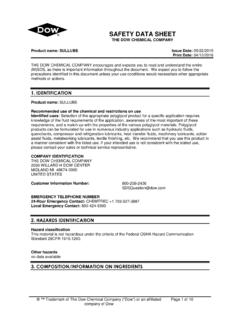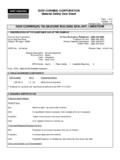Transcription of 1. Product and Company Identification
1 Product Name: DOWANOL* PM GLYCOL ETHER Issue Date: 04/08/2010 Print Date: 11 Feb 2011 (TM)*Trademark of The Dow chemical Company ("Dow") or an affiliated Company of Dow Page 1 of 9 The Dow chemical Company encourages and expects you to read and understand the entire (M)SDS, as there is important information throughout the document. We expect you to follow the precautions identified in this document unless your use conditions would necessitate other appropriate methods or actions. 1. Product and Company Identification Product Name DOWANOL* PM GLYCOL ETHER Company Identification The Dow chemical Company 2030 Willard H. Dow Center Midland, MI 48674 USA Customer Information Number: 800-258-2436 EMERGENCY TELEPHONE NUMBER24-Hour Emergency Contact: 989-636-4400 Local Emergency Contact: 989-636-4400 2. Hazards Identification Emergency Overview Color: Colorless Physical State: Liquid. Odor: Ether Hazards of Product :WARNING! Flammable liquid and vapor.
2 May cause skin irritation. Keep upwind of spill. Isolate area. Vapor explosion hazard. Vapors may travel a long distance; ignition and/or flash back may occur. Stay out of low areas. Warn public of downwind explosion hazard. OSHA Hazard Communication Standard This Product is a "Hazardous chemical " as defined by the OSHA Hazard Communication Standard, 29 CFR Potential Health Effects Eye Contact: May cause slight temporary eye irritation. Corneal injury is unlikely. Skin Contact: Prolonged contact may cause skin irritation with local redness. Repeated contact may cause skin irritation with local redness. Material Safety Data Sheet The Dow chemical Company Product Name: DOWANOL* PM GLYCOL ETHER Issue Date: 04/08/2010 Page 2 of 9 Skin Absorption: Prolonged skin contact with very large amounts may cause dizziness or drowsiness. Repeated skin contact may result in absorption of harmful amounts. Inhalation: Brief exposure (minutes) is not likely to cause adverse effects.
3 The odor is objectionable at 100 ppm; higher levels produce eye, nose, and throat irritation and are intolerable at 1000 ppm. Anesthetic effects are seen at or above 1000 ppm. Ingestion: Very low toxicity if swallowed. Small amounts swallowed incidentally as a result of normal handling operations are not likely to cause injury; however, swallowing larger amounts may cause injury. Aspiration hazard: Based on physical properties, not likely to be an aspiration hazard. Effects of Repeated Exposure: Symptoms of excessive exposure may be anesthetic or narcotic effects; dizziness and drowsiness may be observed. In animals, effects have been reported on the following organs: Kidney. Liver. Birth Defects/Developmental Effects: Has been toxic to the fetus in laboratory animals at doses toxic to the mother. Reproductive Effects: In laboratory animal studies, effects on reproduction have been seen only at doses that produced significant toxicity to the parent animals.
4 Component CAS # Amount Propylene glycol monomethyl ether 107-98-2 >= % 2-Methoxy-1-propanol 1589-47-5 < % 4. First-aid measures Eye Contact: Flush eyes thoroughly with water for several minutes. Remove contact lenses after the initial 1-2 minutes and continue flushing for several additional minutes. If effects occur, consult a physician, preferably an ophthalmologist. Skin Contact: Wash skin with plenty of water. Inhalation: Move person to fresh air; if effects occur, consult a physician. Ingestion: If swallowed, seek medical attention. Do not induce vomiting unless directed to do so by medical personnel. Notes to Physician: No specific antidote. Treatment of exposure should be directed at the control of symptoms and the clinical condition of the patient. Emergency Personnel Protection: If potential for exposure exists refer to Section 8 for specific personal protective equipment. 5. Fire Fighting Measures Extinguishing Media: Water fog or fine spray.
5 Dry chemical fire extinguishers. Carbon dioxide fire extinguishers. Foam. Do not use direct water stream. Straight or direct water streams may not be effective to extinguish fire. Alcohol resistant foams (ATC type) are preferred. General purpose synthetic foams (including AFFF) or protein foams may function, but will be less effective. Fire Fighting Procedures: Keep people away. Isolate fire and deny unnecessary entry. Stay upwind. Keep out of low areas where gases (fumes) can accumulate. Water may not be effective in extinguishing fire. Use water spray to cool fire exposed containers and fire affected zone until fire is out and danger of reignition has passed. Fight fire from protected location or safe distance. Consider the use of unmanned hose holders or monitor nozzles. Immediately withdraw all personnel from the area in case of rising sound from venting safety device or discoloration of the container. Burning liquids may be extinguished by dilution with water.
6 Do not use direct water stream. May spread fire. Eliminate ignition sources. Move container from fire area if this is possible without hazard. Burning liquids may be moved by flushing with water to protect personnel and minimize property damage. 3. Composition Information Product Name: DOWANOL* PM GLYCOL ETHER Issue Date: 04/08/2010 Page 3 of 9 Special Protective Equipment for Firefighters: Wear positive-pressure self-contained breathing apparatus (SCBA) and protective fire fighting clothing (includes fire fighting helmet, coat, trousers, boots, and gloves). If protective equipment is not available or not used, fight fire from a protected location or safe distance. Unusual Fire and Explosion Hazards: Container may rupture from gas generation in a fire situation. Violent steam generation or eruption may occur upon application of direct water stream to hot liquids. Vapors are heavier than air and may travel a long distance and accumulate in low lying areas.
7 Ignition and/or flash back may occur. Flammable mixtures may exist within the vapor space of containers at room temperature. Flammable concentrations of vapor can accumulate at temperatures above flash point; see Section 9. Hazardous Combustion Products: During a fire, smoke may contain the original material in addition to combustion products of varying composition which may be toxic and/or irritating. Combustion products may include and are not limited to: Carbon monoxide. Carbon dioxide. 6. Accidental Release Measures Steps to be Taken if Material is Released or Spilled: Small spills: Absorb with materials such as: Sand. Vermiculite. Collect in suitable and properly labeled containers. Large spills: Contain spilled material if possible. Ground and bond all containers and handling equipment. Pump with explosion-proof equipment. If available, use foam to smother or suppress. See Section 13, Disposal Considerations, for additional information.
8 Personal Precautions: Isolate area. Refer to Section 7, Handling, for additional precautionary measures. Keep unnecessary and unprotected personnel from entering the area. Keep personnel out of low areas. Keep upwind of spill. Ventilate area of leak or spill. No smoking in area. Eliminate all sources of ignition in vicinity of spill or released vapor to avoid fire or explosion. Vapor explosion hazard. Keep out of sewers. For large spills, warn public of downwind explosion hazard. Check area with combustible gas detector before reentering area. Ground and bond all containers and handling equipment. Eliminate all sources of ignition in vicinity of spill or released vapor to avoid fire or explosion. Ground and bond all containers and handling equipment. Use appropriate safety equipment. For additional information, refer to Section 8, Exposure Controls and Personal Protection. Environmental Precautions: Prevent from entering into soil, ditches, sewers, waterways and/or groundwater.
9 See Section 12, Ecological Information. 7. Handling and Storage Handling General Handling: Avoid contact with eyes, skin, and clothing. Wash thoroughly after handling. Avoid breathing vapor. Use with adequate ventilation. Keep container closed. Never use air pressure for transferring Product . No smoking, open flames or sources of ignition in handling and storage area. Vapors are heavier than air and may travel a long distance and accumulate in low lying areas. Ignition and/or flash back may occur. Electrically bond and ground all containers and equipment before transfer or use of material. Containers, even those that have been emptied, can contain vapors. Do not cut, drill, grind, weld, or perform similar operations on or near empty containers. Use of non-sparking or explosion-proof equipment may be necessary, depending upon the type of operation. Keep away from heat, sparks and flame. See Section 8, EXPOSURE CONTROLS AND PERSONAL PROTECTION. This Product is a poor conductor of electricity and can become electrostatically charged, even in bonded or grounded equipment.
10 If sufficient charge is accumulated, ignition of flammable mixtures can occur. Handling operations that can promote accumulation of static charges include but are not limited to mixing, filtering, pumping at high flow rates, splash filling, creating mists or sprays, tank and container filling, tank cleaning, sampling, gauging, switch loading, vacuum truck operations. Other Precautions: Spills of these organic materials on hot fibrous insulations may lead to lowering of the autoignition temperatures possibly resulting in spontaneous combustion. Storage Flammable mixtures may exist within the vapor space of containers at room temperature. Keep container closed. Minimize sources of ignition, such as static build-up, heat, spark or flame. Store in Product Name: DOWANOL* PM GLYCOL ETHER Issue Date: 04/08/2010 Page 4 of 9 the following material(s): Carbon steel. Stainless steel. Phenolic lined steel drums. Do not store in: Aluminum. Copper. Galvanized iron.






